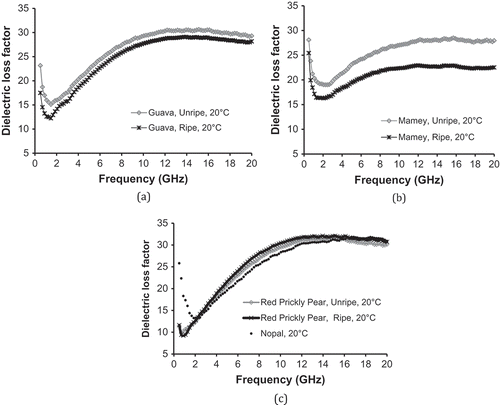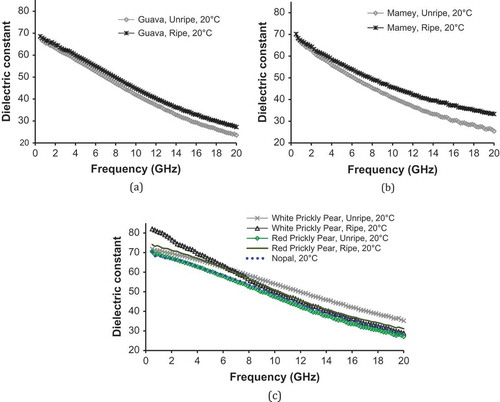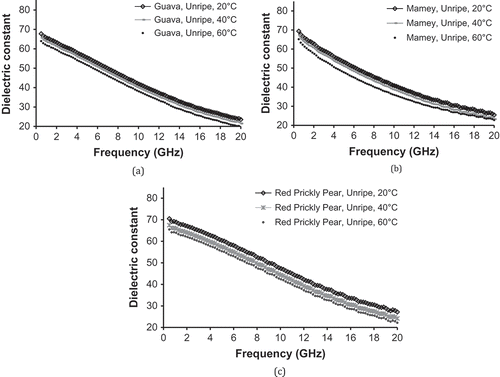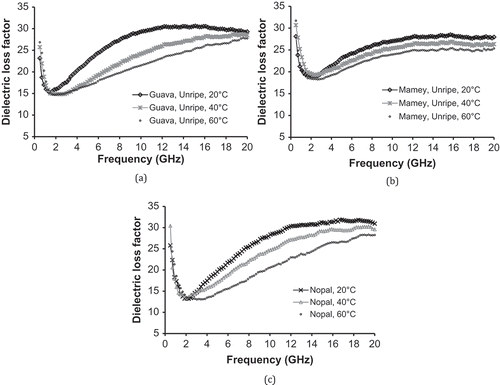ABSTRACT
Dielectric properties (DPs) of selected fruits: guava (Psidium guajava), mamey sapote (Pouteria sapota), red prickly pear (fruit from Opuntia streptacantha), and white prickly pear (fruit from Opuntia ficus-indica), as well as nopal (young cactus pads or cladodes from Opuntia ficus-indica) were studied. DPs were determined using the open-ended coaxial probe method at microwave frequencies (500 MHz–2 GHz) and temperatures of 20, 40, and 60ºC. At 20ºC and 915 MHz for unripe fruits, dielectric constant values ranged from 65.7 to 70.9, while the loss factor had values between 8.4 and 20.7. Both dielectric constant and dielectric loss factor were affected by temperature and frequency (p < 0.05). For example, loss factor for red prickly pear at 2450 MHz decreased from 13.88 at 20ºC to 12.8 at 40ºC and 11.7 at 60ºC. DPs of fruits were also affected by their ripening (quantified through the maturity index). In addition, penetration depth decreased with increasing frequency, ranging from 1.98 to 4.80 cm at 915 MHz and from 0.25 to 0.41 cm at 5800 MHz. Results are valuable to develop further applications with microwave technology for these foods, such as microwave-assisted disinfestation treatments or microwave drying.
Introduction
Fruits and vegetables are of high nutritional, sensorial, and economical values. Guava fruit (Psidium guajava) is an aromatic tropical fruit native of Mexico and Central America, with many seeds in the center of the pulp. Nowadays, it is recognized as the fruit with the highest vitamin C content (228 mg of ascorbic acid/100 g of fruit),[Citation1] and some cultivars reach 400 mg/100 g and also have important contents of vitamin A.[Citation2] Mamey sapote (Pouteria sapota) is a soft fruit, with orange-color pulp and a big stone in the center; it is a good source of fiber, potassium, and vitamins A and E.[Citation3] Prickly or cactus pear (fruits from Opuntia) is a berry with thick peel and tasty juicy pulp with many seeds. Seeds contain oil composed by important fatty acids, such as oleic, palmitic, and stearic.[Citation4] Moreover, it also contains high levels of minerals, such as Ca, K, Mg, and P.[Citation5] Prickly pear pulp is rich in fiber, amino acids,[Citation6] and natural antioxidants, such as flavonoids and carotenoids.[Citation7] Tender young pads from Opuntia, named “nopal” in Mexico, are green cladodes rich in mucilage (soluble fiber), crude fiber, sugars, organic acids, and phenolic compounds.[Citation8]
Microwave-assisted disinfestation treatments and microwave drying have advantages over conventional methods, since volumetric heating does not degrade the fruits biocompounds as much as traditional heating. In order to develop microwave heating methods, the dielectric properties (DPs) of the foods should be obtained. Dielectric properties of diverse fruits and their nectars have been reported in the literature, such as apple, cherry, grape fruit, and orange;[Citation9] avocado, cherimoya, longan, passion fruit, persimmon and white sapote;[Citation10] mango;[Citation11] tomatoes,[Citation12] garut citrus fruits,[Citation13] apple, apricot, peach, and pear nectars[Citation14] Nevertheless,, to the best of our knowledge, DPs of guava, mamey sapote, cactus pears, and nopal have not been studied
Dielectric properties are described by the complex permittivity (ε) of a given material, expressed as[Citation15]
where the real part ε’ is the dielectric constant, ε” is the dielectric loss factor, and j = √-1. ε’ is related to the capacity of the material to store electrical energy, while ε” is related the absorption mechanisms of energy dissipation and usually, it is significantly smaller than ε’.[Citation16]
Penetration depth (dp) is another important factor associated to the dielectric properties, defined as the depth below a surface of a material at which the power density has decayed by 1/e from the surface value (1/e is around 37%).[Citation16] dp can be calculated from the real permittivity and the dielectric loss factor, as
where dp is the penetration depth (m), c is the speed of the light in free space (3 x 108 m/s), and f is the frequency (Hz). Since the dielectric properties of foods are affected by frequency, temperature, and ripening,[Citation9–Citation13,Citation16,Citation17] in this work, we studied the dielectric properties of the aforementioned fruits in the microwave range from 500 MHz to 20 GHz, at different temperatures (20, 40, and 60ºC), and different ripening stages
Material and methods
Samples
Four samples of fruits and cladodes of Opuntia were obtained from local orchards in Cholula, Puebla, Mexico, all harvested in the month of November, 2015. The fruit samples included guava (Psidium guajava), mamey sapote (Pouteria sapota), red prickly pear (cactus pear fruit from Opuntia streptacantha), and white prickly pear (cactus pear fruit from Opuntia ficus-indica). Fruits were chosen in two different stages of ripeness, which were identified as unripe (physiological maturity, still with greenish appearance, hard texture and no sweet taste), and ripe (commercial ripeness, ripe color, soft texture, sweet taste and low acidity). Young cladodes from Opuntia ficus-indica were also brought to the laboratory. Nopal has only one stage of ripeness. All the samples were selected healthy, without signs of insect attacks, illness, fungi presence, or any other defect. Samples were washed with tap water and dried at room temperature. In the case of mamey sapote and prickly pears, peel was removed. For mamey sapote, its stone was also removed. Every sample was cut just previous to analysis, and an individual paste was obtained for each one from their flesh in an electrical blender. One reason to form a paste is to assure temperature homogeneity across the sample. However, it is important to note that since a uniform paste is obtained, no anisotropy studies can be carried out[Citation18] As mentioned by Ryyänen[Citation16], heating characteristics may vary with particle size and distribution, having slightly higher ε’ in laminated structures than compared to granular substances, the author did not mention a possible effect on the ε”. Nevertheless, diverse reports have demonstrated that measuring an isotropic homogeneous fruit-paste resulted in useful data for further applications.[Citation9–Citation13]
Physicochemical analysis in samples
pH was determined with a digital pHmeter (Model pH120, Conductronic, Mexico City), previously calibrated with buffer 7.0 and 4.0. pH was measured by direct immersion of the electrode in the paste of every sample.[Citation11] Total soluble solids (TSS) were determined in the paste of every sample with a digital refractometer (Model HI 96801, Hanna Instruments, Romania), previously calibrated with distilled water at 20ºC.[Citation19] TSS were expressed in ºBx. Titratable acidity was determined by titration with 0.1 N NaOH in 10 g of sample and pHmeter up to pH = 8.2.[Citation20] Titratable acidity was expressed as percentage of the main organic acid present in the fruit. Physicochemical tests were carried out by duplicate. The maturity index of the fruits was calculated by the ratio of TSS/titratable acidity.[Citation21]
Dielectric properties measurement system
Both dielectric constant (ε’) and dielectric loss factor (ε”) of every sample were measured with an open-ended coaxial probe (model 85070E, Agilent Technologies, Fullerton, CA, USA) connected to a vector network analyzer (model N9918A FieldFox, Keysight Technologies, Santa Rosa, CA, USA). The range of measurement was from 500 MHz to 20 GHz. The tip of the probe was calibrated with air, electrical short fitting, and distilled water at 25ºC. Error of the system was about 5% after calibration.[Citation22] Then, 200 g of paste of every sample were placed in a 13.4 cm tall and 5 cm diameter beaker. The tip was immersed 2 cm within the sample, ensuring that the probe had contact with the sample. The initial temperature of the sample was 20ºC. To heat it up to 40 and 60ºC, a hot water bath was used. In order to have a uniform temperature, the sample was constantly stirred. Once the target temperature was reached, ten readings were taken in less than 1 min, and average values were calculated.
Calculation of penetration depth
With the average values of the dielectric properties (ε’ and ε”), the penetration depth (dp) was obtained using Equation 2 at the ISM bands (Industrial, Scientific, and Medical), allocated by the Federal Communications Commission.[Citation23] For our measurement range, the covered ISM microwave frequencies for the purposes of heating are 915, 2450, and 5800 MHz.
Statistical analysis
Results were analyzed by ANOVA and Tukey’s pairwise comparison using the software Minitab 17 (Minitab Inc., State College, PA). Differences between means were established at the significant level of p = 0.05.
Results and discussion
Physicochemical properties of samples
The physicochemical properties of the samples and the ripening of the fruits are shown in . pH and TSS increased with ripeness of the fruits (p < 0.05), while titratable acidity decreased for guava and mamey sapote (p < 0.05). No differences in titratable acidity due to ripeness (p > 0.05) were observed for any of the prickly pears, since they are fruits with neutral pH and low acidity. The maturity index revealed that the ripeness stage was significantly different among ripe and unripe samples, especially in climacteric fruits, such as guava and mamey sapote.
Table 1. Average physicochemical parameters of studied fruits and no pal.
Real permittivity (dielectric constant) of fruits and nopal
shows the trend of dielectric constant for (a) guava and (b) mamey sapote fruits with respect to frequency at 20ºC. As it is seen, the dielectric constant decreased with frequency. Ripe fruits (guava with 12.2ºBx and mamey sapote with 33ºBx) had slightly higher ε’ values than unripe samples (guava with 11.9ºBx and mamey sapote with 25ºBx), without changes under 4 GHz (p > 0.05). For prickly pears and nopal (Fig. 1c), dielectric constant also decreased with increasing frequency. For red and white prickly pears, ripe fruits had higher ε’ values than unripe pears for all the ISM frequencies (). However, for frequencies higher than 7 GHz, ripe fruits had lower ε’ values than unripe ones. Among all the samples, white prickly pear had the highest ε’ value at 500 MHz, followed by red prickly pear, nopal, mamey sapote, and finally, guava. Even though guava exhibited the lowest pH values among the analyzed fruits (), no significant effect of pH on the DPs was observed (–). This observation is in agreement with the reported by Ryynanen,[Citation16] who cited that pH does not affect the properties per se, at typical values of foods. Both types of prickly pears had the highest ε’ values, reaching 80.6 for white pear at 915 MHz and 20ºC (). This can be related to high water content. The measured dielectric constant for guava (65.7) and mamey sapote (66.1–67.1) at 915 MHz and 20ºC () are similar to the reported for other tropical/subtropical fruits, such as longan (68.2), persimmon (68.4), and white sapote (62.6)[Citation10]
Table 2. Average dielectric constant (ε’), dielectric loss factor (ε”), and penetration depth (dp) of guava and mamey sapote fruits, ripe, and unripe stages, at ISM (Industrial, Scientific and Medical) frequencies.
Table 3. Average dielectric constant (ε’), dielectric loss factor (ε”), and penetration depth (dp) of prickly pear (or cactus pear fruit), white and red variety, ripe, and unripe stages, at ISM (Industrial, Scientific and Medical) frequencies.
Table 4. Average dielectric constant (ε’), dielectric loss factor (ε”), and penetration depth (dp) of nopal (cladode from Opuntia) at ISM (Industrial, Scientific, and Medical) frequencies.
The dielectric constant of the samples decreased with increasing temperature. shows this trend for the unripe samples of selected fruits. For example, ε’ for red prickly pear at 20°C is 70.4 at the lowest frequency (500 MHz); it decreases to 27.1 at the highest frequency (20 GHz). At 40°C and 500 MHz, the value is 67.4 decreasing to 24.1 at 20 GHz; at 60°C (500 MHz), the value is 65.4, decreasing to 22.1 at 20 GHz. The same ε’ behavior with respect to temperature was reported for other fruits, such as mango,[Citation11] apples, cherries, and oranges.[Citation9] At microwave frequencies, foods with high moisture content show that ε’ decreases with increasing temperature.[Citation16]
Dielectric loss factor of fruits and nopal
The trend of dielectric loss factor for guava, mamey sapote, and prickly pear at 20ºC in the range from 500 MHz to 20 GHz is shown in . Data for ISM frequencies are shown in , , and 4. From , it is observed that the dielectric loss factor has a “U” shape behavior, beginning with high values at 500 MHz, then falling at frequencies around 2 GHz and exponentially increasing again at higher frequencies until 20 GHz. This behavior below 1800 MHz has also been reported for other fruits.[Citation9–Citation11] The U shape behavior has been studied by Ryynänen,[Citation16] where he concluded that for foods with high moisture content, ε”increases with decreasing frequency, due to a greater influence of conductivity losses at lower frequencies. However, losses due to dipolar relaxation become more important at higher frequencies; therefore, the dielectric loss factor increases for frequencies higher than about 3 GHz.
Figure 3. Dielectric loss factor of (a) guava, (b) mamey sapote, and (c) red prickly pear and nopal at 20ºC.

There was an effect of ripeness on the loss factor for guava and mamey sapote ( and ), with ε” values significantly higher for unripe fruits than the found for ripe samples for frequencies higher than 2 GHz (p < 0.05). No effect in ε” from ripeness was observed for prickly pears (p > 0.05), as it is shown in Fig. 3c.
Among the studied samples, lower values of ε” at 500 MHz were observed for red prickly pear (12) and mature guava (17.4), which was related to the presence of seeds in the flesh, therefore, reducing the amount of water. The highest dielectric loss factor was observed at 500 MHz for unripe mamey sapote (ε” = 28), followed by nopal (ε” = 25.7). At high frequencies, such as 14 GHz, guava, red prickly pear, and nopal reached ε” values of 30, while mature mamey sapote only reached values around 21–22 (). Of all the samples, the unripe mamey sapote has the highest dielectric loss factor, with ε” values of 20.7, 24.2, and 21.1 at 20, 40, and 60ºC, respectively, at 915 MHz (). At 5800 MHz, all the samples had ε”values from 15.8 to 24.
Temperature also affected the dielectric loss factor of the samples. depicts a decreasing loss factor with increasing temperature for guava, mamey sapote, and nopal. The same trend was observed for both prickly pears. Values at ISM frequencies for all the studied samples appear in , , and 4. Dielectric loss factor decay with increasing temperature has also been reported for other fruits, such as apples, cherries, grape-fruits, oranges, cherimoya, longan, passion fruit, persimmon, and white sapote.[Citation9,Citation10]
Penetration depth in fruits and nopal
, , and 4 show the calculated penetration depth at ISM frequencies for all samples. dp values decrease with increasing temperature and frequency for all the fruits. In the case of nopal, penetration depth was affected by frequency, while temperature did not have a specific trend.
At a fixed temperature of 20ºC and frequency of 915 MHz, dp in most fruits ranged between 1.93 cm (unripe mamey sapote) and 4.80 cm (unripe prickly pear). With these dp values, the microwave radiation could reach the center of the fruit for all studied samples. For example, in guavas, dp was 3.32 cm for ripe items, assuring that microwaves at 915 may penetrate all the way to the center (fruits had around 5–6 cm of diameter). Although dp decreases with increasing temperatures, dp at 915 and 60ºC still shows a good penetration level for disinfestation purposes. Insects, in their larvae stage, may advance from surface—where eggs are normally layed—to the center of the fruit eating the flesh. In addition, dp values for all ISM frequencies at high temperatures (40, 60ºC) are enough for controlling molds, as this kind of microorganisms grow on the surface of the peel.
For microwave drying purpose, the dp values are useful to determine the maximum slice thickness needed for efficient drying. These slices should be equal or smaller than the given dp at a certain frequency. That will assure that microwaves will penetrate efficiently, heating and causing water evaporation and the consequent drying of the fruit. In comparison with other studies, penetration on mature mamey sapote fruits at 915 MHz and 60ºC (2.33 cm) is similar than the reported for mangoes (2.43 cm),[Citation9] both fruits with a big stone in their center. At 20ºC and 915 MHz, the fruit with greatest penetration depth was unripe white prickly pear, with 4.8 cm, higher than the reported for other fresh fruits, such as orange (2.7 cm), grapefruit (3.7 cm), cherry (2.8 cm), red delicious apple (4.6 cm),[Citation9] avocado and cherimoya (1.5 cm), longan (3.3 cm), passion fruit (2.7 cm), persimmon (2.1 cm), white sapote (1.8 cm),[Citation10] and mangoes (3.35 cm).[Citation11]
Conclusion
Dielectric constant decreased with frequency and temperature for all the samples. For guava, mamey sapote, and prickly pears, the dielectric constant also increased with ripeness, with values ranging between 41.8 and 80.6. The dielectric loss factor exhibited a “U” shape with respect to frequency for all the samples, with minimum values at around 2 GHz. The dielectric loss factor also decreased with ripeness and temperature, and the ε” values ranged from 9.04 to 24.2. These results are useful for further microwaves treatments, such as disinfestation in fruits or microwave drying of fruits and nopal.
Funding
Authors thank the financial support from CONACyT (Consejo Nacional de Ciencia y Tecnología, Mexico) for Projects 168990 and 180061, and from PRODEP.NPTC 2016, DSA/103.5/16/10374.
Additional information
Funding
References
- USDA (Unites States Department of Agriculture). National Nutrient Database for Standard Reference. Guavas, common, raw. http://ndb.nal.usda.gov/ndb/foods/show/2246?manu=&fgcd= 2016.
- Kader, A.A. Department of Plant Sciences, University of California, Davis. http://postharvest.ucdavis.edu/frutasymelones/Guayaba/( In Spanish). 2016.
- USDA (Unites States Department of Agriculture). National Nutrient Database for Standard Reference. Sapote, mamey, raw. http://ndb.nal.usda.gov/ndb/foods/show/2383?manu=&fgcd= 2016
- Matthaus, B.; Özcan, M.M. Habitat Effects on Yield, Fatty Acid Composition and Tocopherol Contents of Prickly Pear (Opuntia ficus-indica L.) Seed Oils. Scientia Horticulturae 2011, 131, 95–98.
- Al-Juhaimi, F.; Özcan, M.M. Determination of Some Mineral Contents of Prickly Pear (Opuntia ficus-indica L.) Seed Flours. Environmental Monitoring and Assessment 2013, 185, 3659–3663.
- Rodríguez-Hernández, G.R.; González-García, R.; Grajales-Lagunes, A; Ruiz-Cabrera, M.A.; Abud-Archila, M. Spray-drying of Cactus Pear Juice (Opuntia streptacantha): Effect on the Physicochemical Properties of Powder and Reconstituted Product. Drying Technology 2005, 23, 955–973.
- Kuti, J.O. Antioxidant Compounds from four Opuntia Cactus Pear Fruits Varieties. Food Chemistry 2004, 85(4), 527–533.
- Chahdoura, H.; Barreira, J.C.M.; Barros, L.; Santos-Buelga, C.; Ferreira, I.C.F.R.; Achour, L. Phytochemical Characterization and Antioxidant Activity of the Cladodes of Opuntia macrorhiza (Engelm.) and Opuntia microdasys (Lehm.). Food & Function 2014, 5 (9), 2129–2136.
- Wang, S.; Tang, J.; Johnson, J.A.; Mitcham, E.; Hansen, J.D.; Hallman, G.; Drake, S.R.; Wang, Y. Dielectric Properties of Fruits and Insect Pests as Related to Radio Frequency and Microwave Treatments. Biosystems Engineering 2003, 85 (2), 201–212.
- Wang, S.; Monzon, M.; Gazit, Y.; Tang, J.; Mitcham, E.J.; Armstrong, J.W. Temperature-Dependent Dielectric Properties of Selected Subtropical and Tropical Fruit and Associated Insect Pests. Transactions of the ASAE 2005, 48 (5), 1873–1881.
- Sosa-Morales, M.E.; Tiwari, G.; Wang, S.; Tang, J.; García, H.S.; López-Malo, A. Dielectric Heating as a Potential Post-Harvest Treatment of Disinfesting Mangoes I: Relation Between Dielectric Properties and Ripening. Biosystems Engineering 2009, 103, 297–303.
- Peng, J.; Tang, J.; Jiao, Y.; Bohnet, S.; Barret, D.M. Dielectric Properties of Tomatoes Assisting in the Development of Microwave Pasteurization and Sterilization Processes. LWT - Food Science and Technology 2013, 54, 367–376.
- Juansah, J.; Budiastra, I.W., Dahlan, K., Seminar, K.B. Electrical Properties of Garut Citrus Fruits at Low Alternating Current Signal and its Correlation with Physicochemical Properties during Maturation. International Journal of Food Properties 2014, 17 (7), 1498–1517.
- Lombardo, R.; Rubino, T.; Cammalleri, M. Dielectric Characterization of Fruit Nectars at Low RF Frequencies. International Journal of Food Properties 2015, 18 (10), 2312–2326.
- Risman, P.O. Terminology and Notation of Microwave Power and Electromagnetic Energy. Journal of Microwave Power and Electromagnetic Energy 1991, 26, 243–250.
- Ryynänen, S. The Electromagnetic Properties of Foods Materials: A Review of the Basic Principles. Journal of Food Engineering 1995, 26, 409–429.
- Sosa-Morales, M.E.; Valerio-Junco, L.; García, H.S.; López-Malo, A. Dielectric Properties of Foods: Reported Data in the 21st Century and Their Potential Applications. LWT- Food Science and Technology 2010, 43, 1169–1179.
- Abbas, Z.; Yeow, Y.K.; Shaari, A.H.; Khalid, K.; Hassan, J., Saion, E. Complex Permittivity and Moisture Measurements of Oil Palm Fruits Using an Open-ended Coaxial Sensor. IEEE Sensors Journal 2005, 5, 1281.
- NMX-FF-015-1982. Non Industrialized Food Products For Human Use. Fresh Fruits. Determination of Total Soluble Solids. Secretary de Economy, Government of Mexico, Mexico City, 1982.
- AOAC. Official Methods of Analysis; Association of Official Analytical Chemists; Washington, DC, 1994.
- FAO (Food and Agricultural Organization – United Nations Organization). Handling and Preservation of Fruits and Vegetables by Combined Methods for Rural Areas; FAO Agricultural Services. Bulletin 149: Rome, Italy, 2003.
- Kaur, T.K.; Sosa-Morales, M.E.; Olvera-Cervantes, J.L.; Corona-Chávez, A. Dielectric Properties of Tequila in the Microwave Range (0.5–20 GHz) using Coaxial Probe. International Journal of Food Properties 2017. doi: 10.1080/10942912.2017.1297949
- USDA (Unites States Department of Agriculture). Kinetics of Microbial Inactivation for Alternative Food Processing Technologies. Microwave and Radio Frequency Processing. http://www.fda.gov/Food/FoodScienceResearch/SafePracticesforFoodProcesses/ucm100250.htm 2015.



